Due to the fact that bringing OLIVIA to Hamburg took us only 3 instead of the anticipated 5 days (Here´s part 2 of our “big” adventure) and so I was lucky to have some days “spare” before bringing her to winter storage. Precious time for me, because I really underestimated the amount of expenditure to prepare my yacht for storage, to bring her out of the water and on dry land. Here´s what I´ve experienced.
Why putting my yacht in winter storage anyway?
A boat is made for the seas, right? So why take it out of it´s element anyway? We don´t have freezingly cold winters anymore, temperatures won´t drop below zero too much – it is said that there are to be some ice-free marinas in the Netherlands where a lot of boats remain afloat in the water during winter-time. So why do we do all that hustle?
First of all a GRP-boat needs to be fully cleaned after a season in the water. As good as modern antifouling might be, it cannot safe the boat from all negative environmental influences, encrustation or other organic influences. Even small glitches, scratches or bumps from all-too risky maneuvers should be repaired as soon as possible and some new layers of conservatory polish do not only add up to the beauty of the ship but also to her longevity.
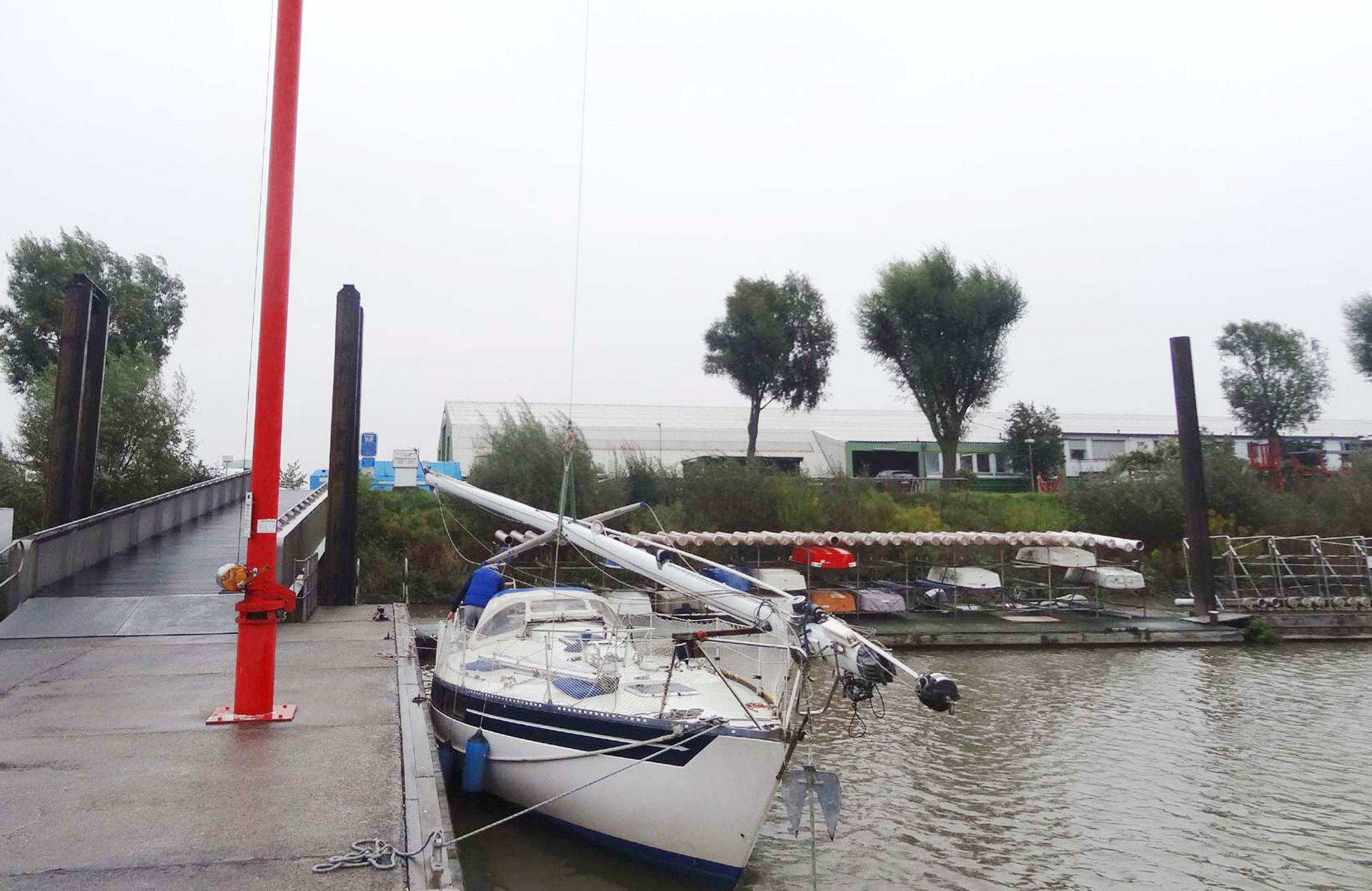
For me personally taking OLIVIA out of the water has another reason: I want to fully get to know her, work my way through the boat from keel to mast-top and give her the refurbishments needed. Still, she is a 40 year old lady and thus needs some attention.
Best way to do it is on dry land.
Best time to do it is winter-season.
De-rigging and craning the yacht.
Before a boat can be put on land it has to be freed of all the rigging, lines and ropes. Bringing down the mast is a fairly simple and complex task altogether. You “just” have to slack away forestay and backstay, let loose the shrouds and lay down the mast. Well, removing the standing rigging from OLIVIA, this much I knew, should be done by a professional. I have seen it multiple times, but never done it by myself, so I was lucky that a friend recommended an experienced rigger who was friendly enough to visit us on board prior to the date.
“Remove the sails and all running rigging.”, he advised whilst having a cup of coffee on board: “Take down the spar and lush it away. Remove all sealings from the terminals, disconnect the electrical wiring going up the mast and clean the deck.” Well, that´s quite a list of tasks and fresh off to work that list filled my whole following day. Sacking the sails alone took hours, taking down the spar and removing all sealings were the easier part.
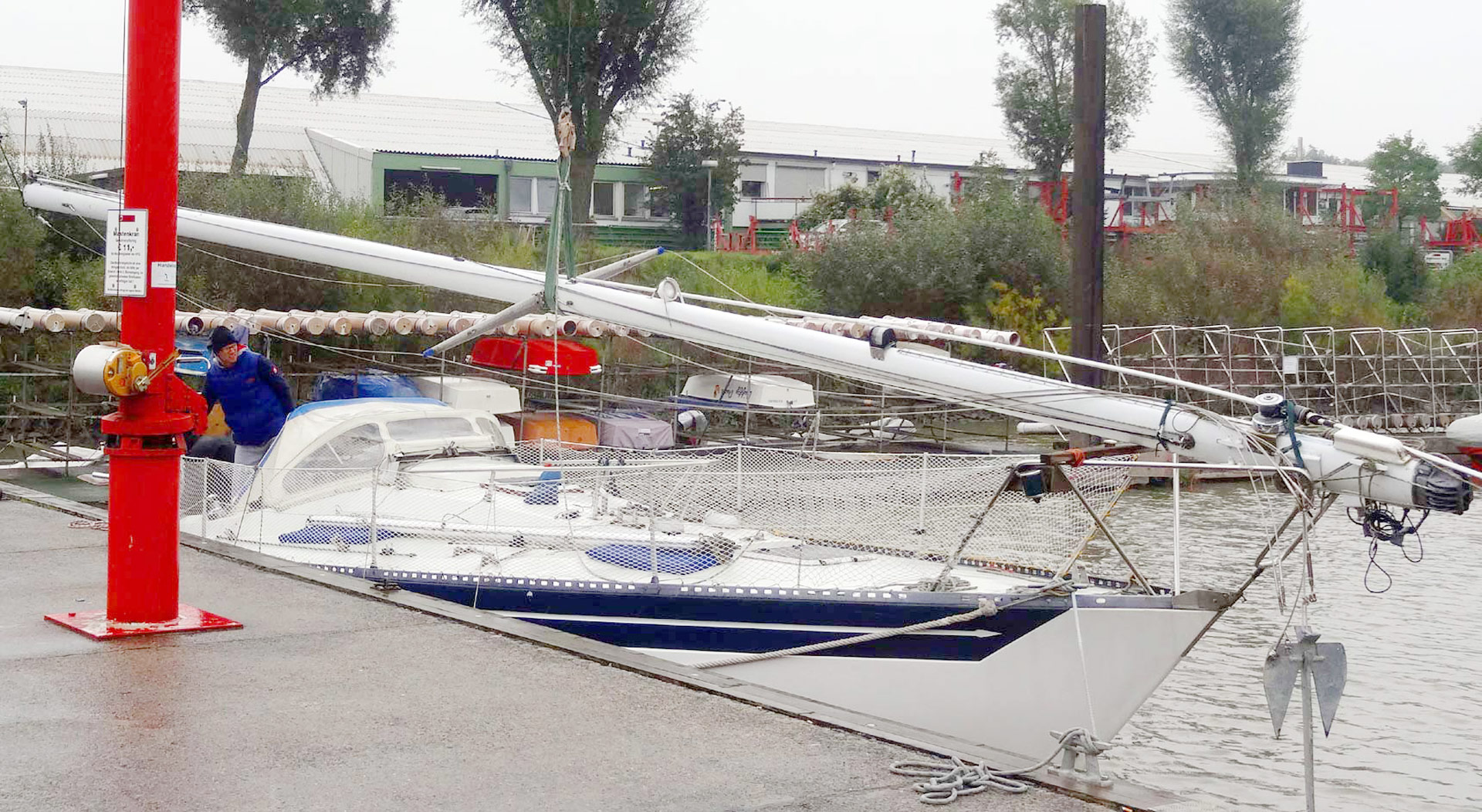
“You should bear in mind that the mast comes down on deck all the way from bow to stern.”, the Rigger further adviced: “So you should build stands of solid wood which will support the mast and distribute it´s weight evenly on the deck-structure.” It took me some hours as well to take the measurements, buy the wood and bring everything together – just as good to use the construction during the next winter-seasons. So, just prepping the boat for taking down the mast took full 2 days – what a luck having arrived early!
Next day, cold air with light rain, the Rigger arrived in time in a good mood. I had already steered OLIVIA alongside the mast-crane and it took us some 2 hours to take down the mast. Quite an interesting task and a good chunk of work for the Rigger. But after all nothing all-too special in the end. I guess after having watched the mast coming up again next season it should be a small problem for me to take it down the next time by myself. At one o´clock OLIVIA was back in her berth and I could resume emptying her for winter storage.
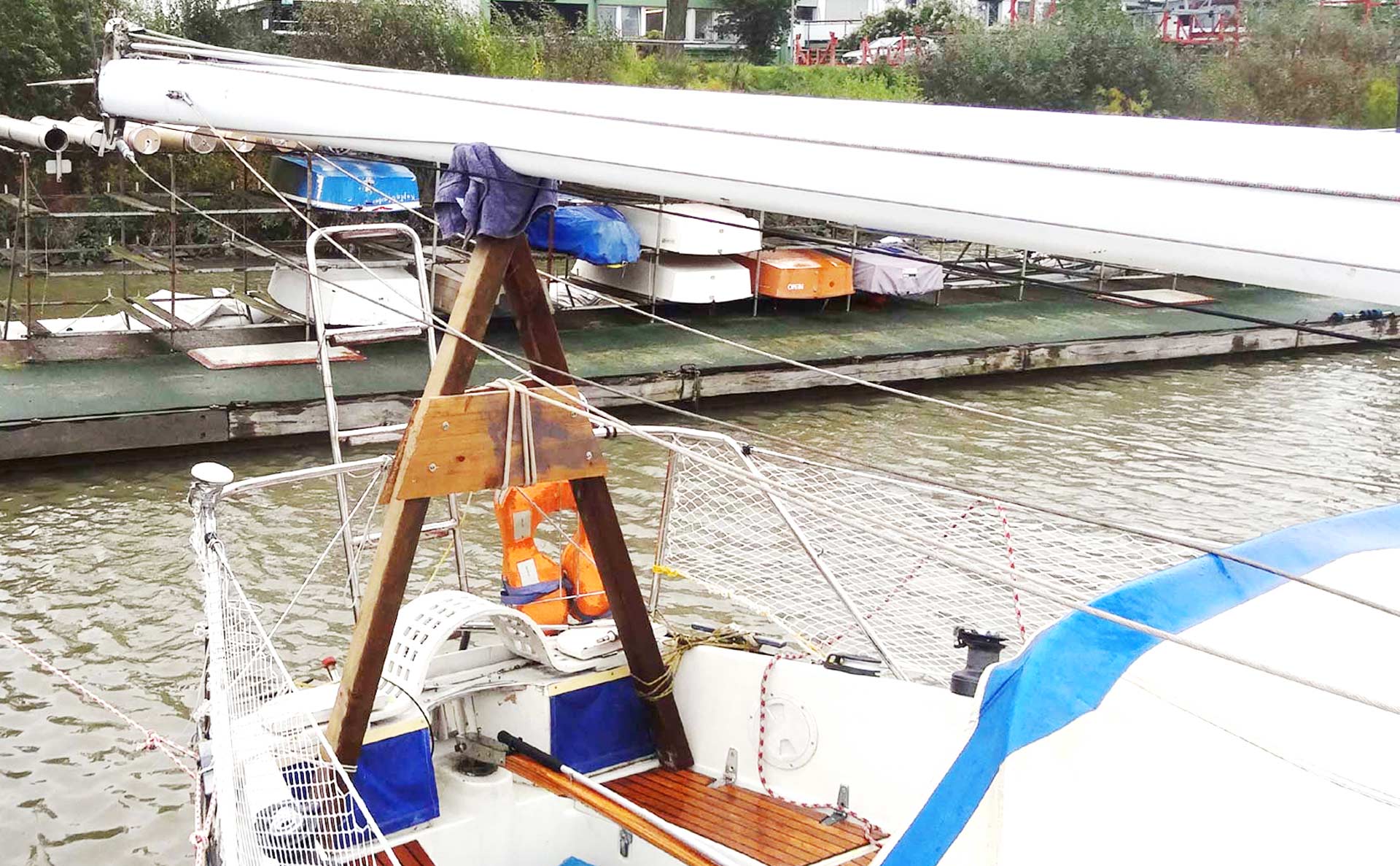
Overnight the weather worsend even more. Temperatures dropped, rain increased and so did the wind. We had our craning-timeframe set for 9.10 a.m. – a tight schedule in the face of the fact that some few hundred yachts in Yachthafen Hamburg alone needed to be craned. So we cleared all ropes for casting off, pre-warmed the engine and were doing waiting loops in the tight harbour waters well before time. It was a good chance for me to test OLIVIA´s response under engine in various circumstances: Backwards, full starboard rudder with the help of the wheel-effect and turning on one spot. Besides, I could observe the whole craning procedure by looking at other yachts. Quite a delicate maneuver: I´d have to bring her alongside the craning-quay with just enough speed to gently push her into the ropes. With nasty gusty winds from astern and virtually no experience in maneuvering our 33-feet-yacht accurate to a millimeter my heart was beating fast – I didn´t want to add further scratches to OLIVIA´s hull. Besides: Above our heads some people were closely watching every action I took.
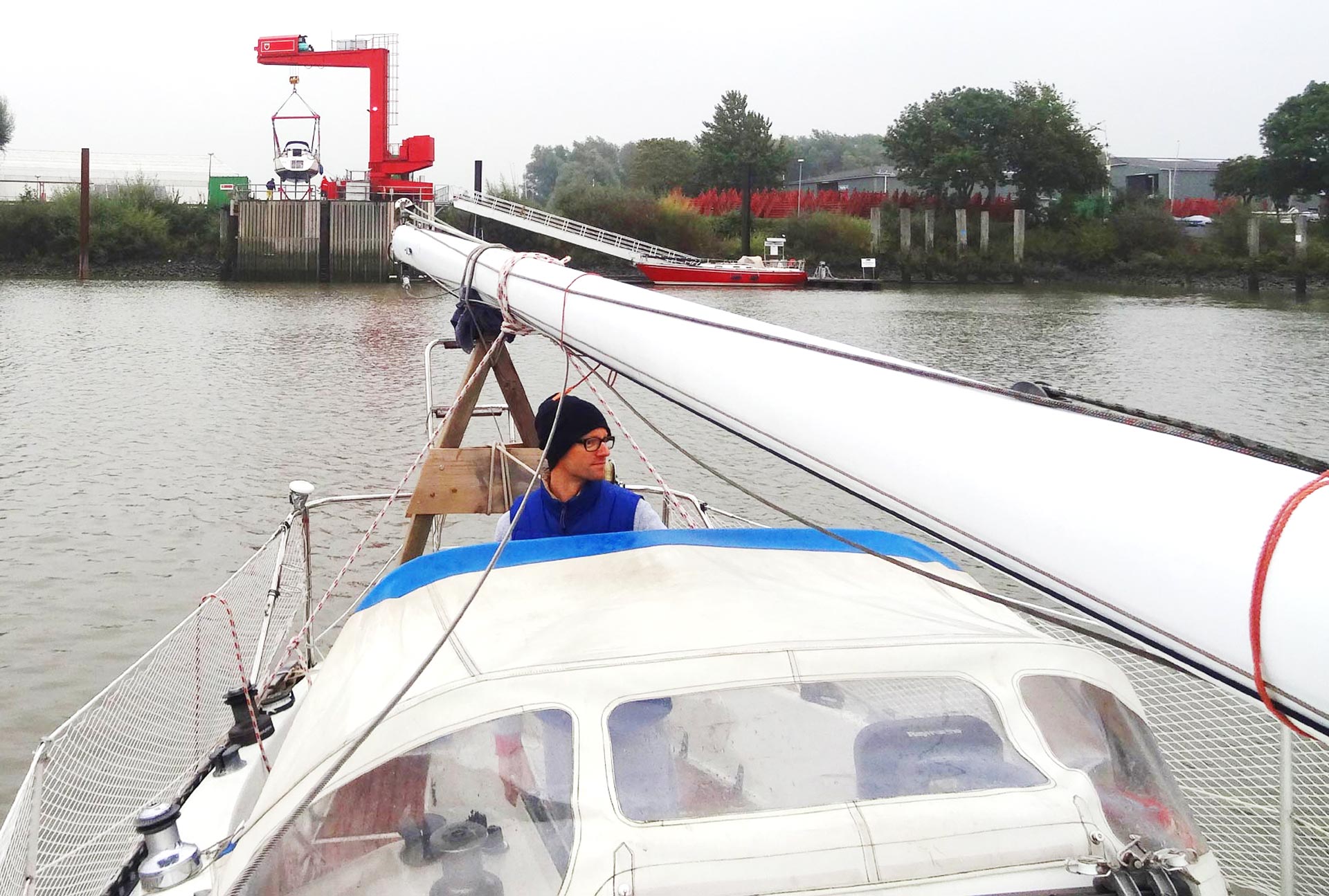
Call it luck of the beginner: I was able to bring her between the ropes ever so smoothly.
The craning-gang took her out of water in a matter of minutes. It was a touching moment seeing her fly above my head, dripping wet, her blue hull against a grey sky. Back on the rack the transporter took her to her stand some 4 kilometres away where she came to rest at one o´clock. The whole procedure didn´t last longer than 4 hours – in my memories it was like a whole week of hardship. So, in the end, it was 3 days of prepping the boat to be brought up on dry land. Good to know for the next time …
Do you prefer your yacht inside a hall or outside?
To be honest, I´d rather put my yacht inside a hall than letting her on stand outside. Since my boat is a “she” with a soul, the concept of her standing outside during raging storms, snowfall and freezng temperatures is annoying. Apart from the fact that I was lucky to even have gotten a standing place in the outside at all – all of Hamburgs storage-places are already pre-booked for years or simply just not affordable.
Standing inside has some undeniable virtues: It´s dry inside all the time and theres no imminent danger of severe storms. But there´s a downside to it as well: Often times and types of work to be done at the yacht are restricted. Imagine 250 yacht-owners are grinding, painting or laminating their boats at the same time. All the noxious odors, dust and abfälle would drive everyone crazy in a matter of hours. During extrem low temperatures the hall – if not heated – will be as cold as outside as well, sometimes even colder: The cast iron keels will store the cold and function as ice-batteries, charging the hall with coldness – even if temperatures outside are higher.
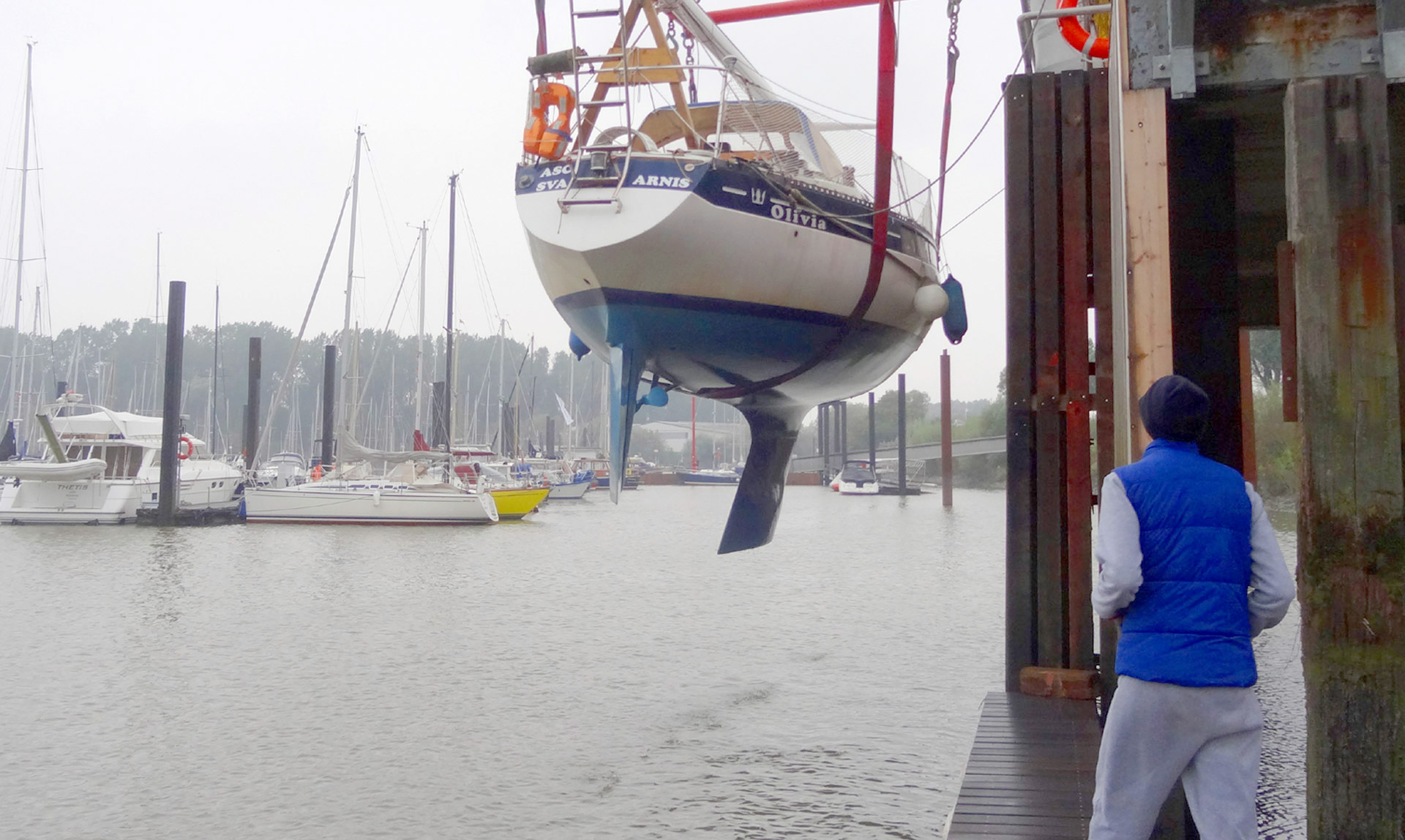
So, from the working point of view being outside is the better choice. Since I want to refurbish OLIVIA´s interior as a whole and her underwater hull as well, it was good not having been offered an inside stand.
Under bare skies – but not unprotected.
Placing a yacht outside doesn’t mean to let her unprotected. There are a lot of offers for protecting covers ranging from custom-made tarpaulins which will suit your particular yacht like a tailor-made tuxedo to tarps in various lengths and widths to choose from. Prices differ also greatly. You may pay from 1.500 € upwards for the luxurious option and starting at 80 € for 8 x 3 metres tarp up to 250 € for a 34-feet suitable cover.
I decided to build a tarpaulin by myself – which you will get to read in detail in one of the upcoming articles. In short: By building my own tarp I could order a blank piece of cover by my own boat´s measurements, I just had to put lugs into the tarp. I chose a white tarp, lighting up the inside during daylight.
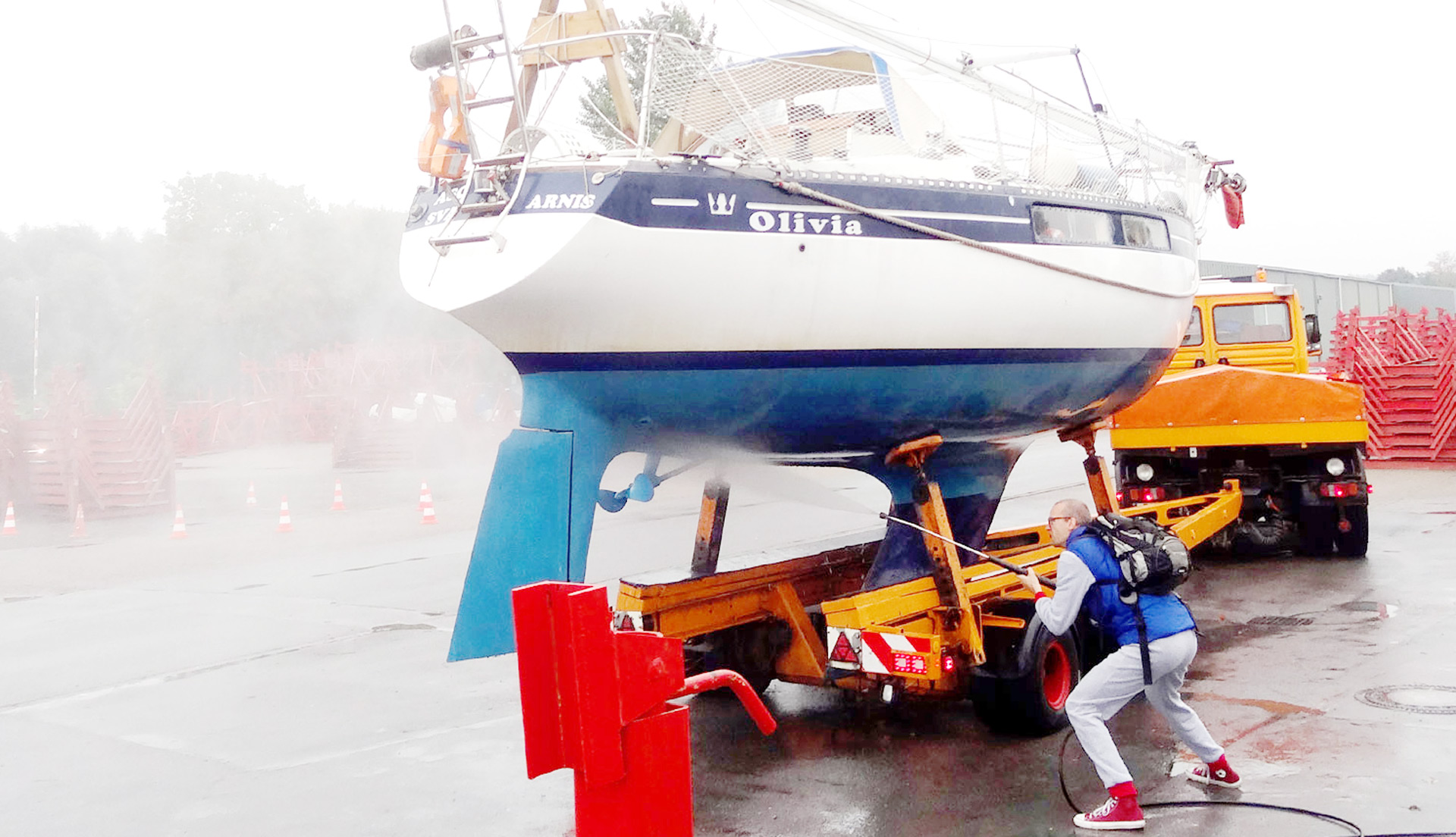
So, the yacht will be outside, but not unprotected against bad weather.
Winterproof toilet, pumps and the Volvo Penta-engine.
After arriving at her stand, I began to make her most important parts winterproof. I started by emptying the pump-toilet. After flushing out some 20 litres of clean sweet water (with a splash of organic shampoo for the good smell) I emptied the whole system and that was it. Let open all vents and valves will do. I then do flush the whole system twice, maybe three times with clean sweet water and some biodegradable dish detergents. That´s it.
Freshwater-tank was emptied to the bottom (analoguous to the Diesel-tank, which has to be filled up to the upper edge to avoid condensation). Don´t forget to completely empty the water-pump by letting her pump out the last drop of water as well. Second part done, not an hour of work.
Most work is to be invested in winterproofing the Diesel engine. There is a load of advice on the internet, the guidelines by Volvo Penta as well and a big variety of good recommendations how to best make the motor survive low temps.
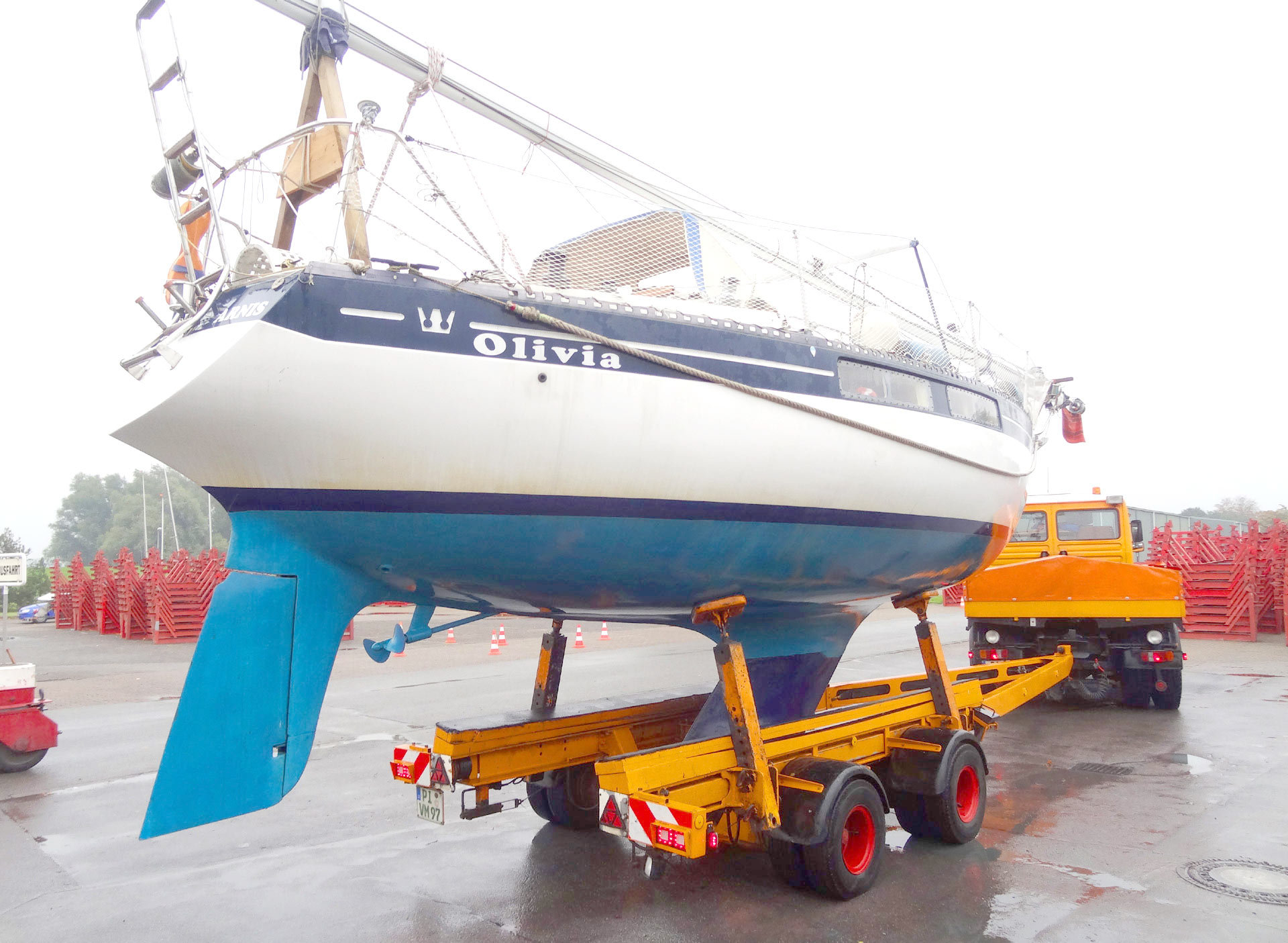
Here´s mine: After adding anti-freeze to the secondary cooling system I started the engine to let her run for one small minute: The primary cooling system depending on seawater will run dry this way, by pumping the freshly added anti-freeze through the whole secondary system it will be distributed all along the engine. That´s it. I won´t dismount the impeller. I won´t change the whole secondary coolant. Winters here in Germany tend to get warmer every year so I think that there´s no need to run the big program. That´s something for every third or fourth winter, I guess.
Batteries in winter: Dismounting or charging?
Check for your batteries. There are some types which are not freeze-safe. They should be taken off the boat and stored dry and warm. Mine are freezing-safe. Lucky me: Those batteries weigh the hell of a load. Removing them would mean a mean job …
Many owners I know keep their boats on the grid all the time. If you have mounted a load-balancer that´s a wise decision – just check your storage-facility-owner if this is possible. Since I don´t have such an installation, I will have to put the boat back on the grid at least every month to recharge the batteries. Remember: Never let the run full empty, that´s something they won´t like. And never let them be charged all the time either.

You should also refrain from running a heater inside the boat. Apart from the fact that this is a waste of precious energy – it´s also dangerous. I´ve read some reports on raging fires caused by unattended heaters. Besides, there are other techniques to keep a boat dry.
Keeping your yacht dry.
Winter is a cold and very humid season. Since we won´t get the “real” winters anymore, we could expect a lot of rain, snowy rain and due to the shining sun masses of humid air. So how to best keep your yacht dry and vented at the same time?
I´ve bought a sack of drying powder. You just cut open the plastic sack and place a basket under it. Check every 2 months at least and replace the old one if needed. It will keep your yacht sufficiently dry from most of humidity during winter – and don´t forget to let open a porthole since there´s nothing more annoying than growing mildew and fusty smell inside the boat. Of course you will take off all the expensive electrical equipment, like your Raytheon-Plotter and take it home with you. After having done this – it´s time to let loose. Or, as in my case, the real work begins.
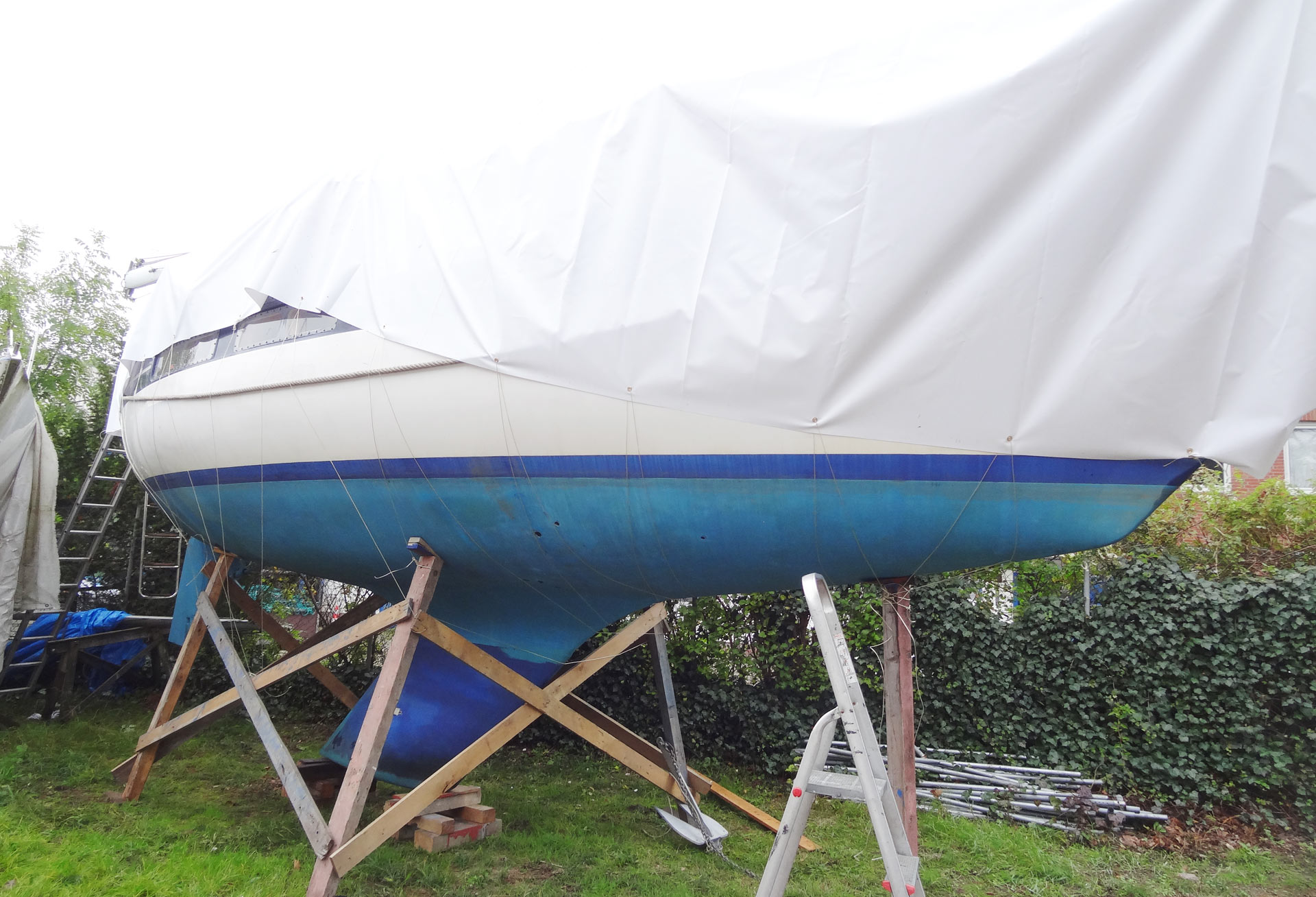
Prepped everything? Then onto your refurbishing project.
As you will get to read in the upcoming posts, I am going to do a complete refurbishing of OLIVIA´s interior, all wooden parts, the inside-gelcoat, her bilge, retrofit her to LED-lighting, re-do all her cushion and ceiling. Quite a project: So after having her safe on dry land I instantly began to completely empty my boat.
Having bought a nearly 40 year old ship with two pre-owners, I could expect to find a load of stuff: I took off of her everything from bow to stern like all the crockery, tons of candles, did a complete stock-taking of the spare parts (some ended up in trash, some on Ebay, least will return on board) and finally, after two days of work, I started to disassemble all her wooden parts – where possible – as the first step of my big project.
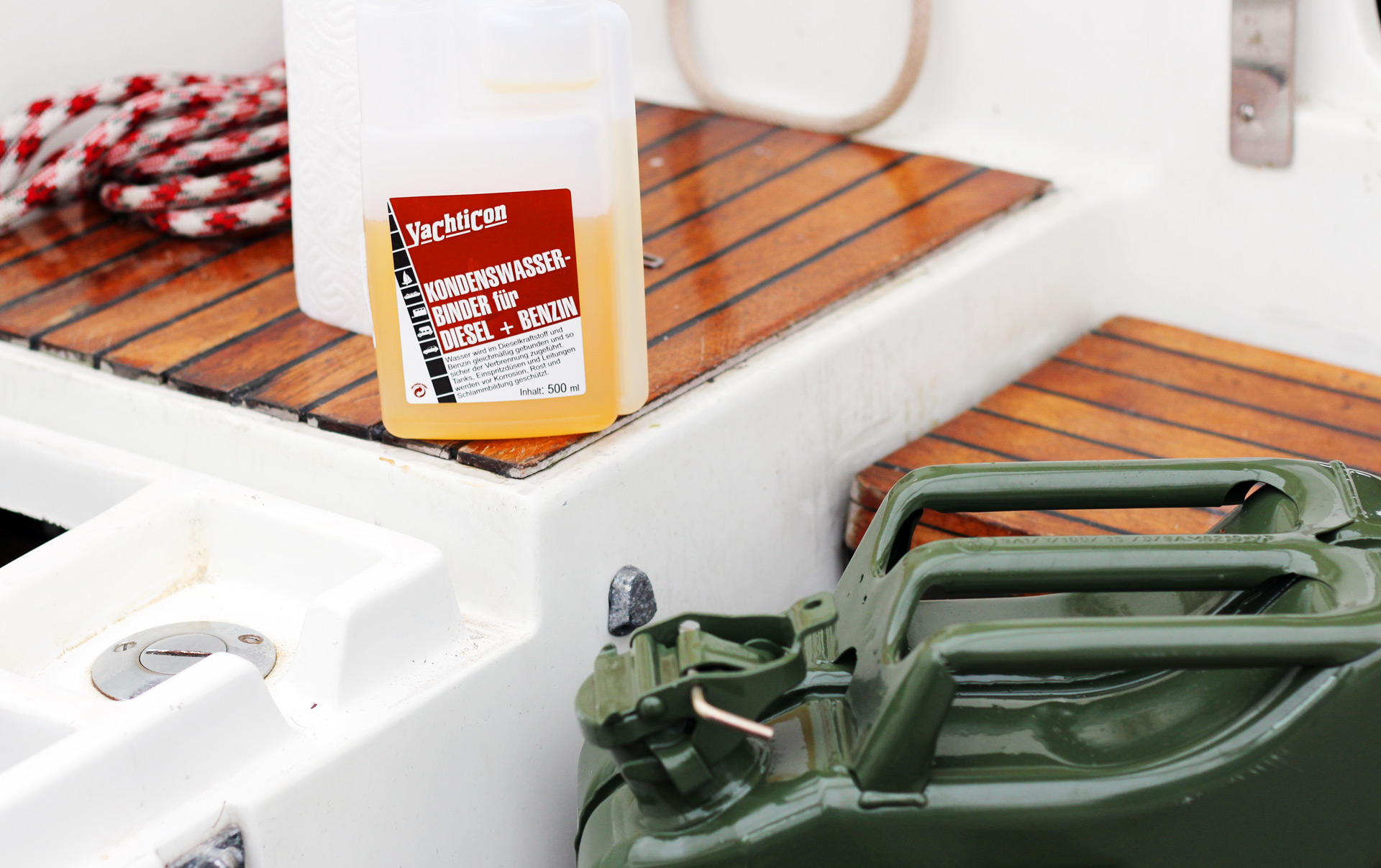
Unfortunately I´ve discovered a crack in OLIVIA´s engine base. Apparently an old but deep one. From my point of view nothing deadly or dangerous, but nevertheless it´s there and thus will be removed. So I´ll get also to know how to refurbish GRP, the art of layering and working with resin. I am thus looking forward to a winter-season full of hard but varied and interesting work ahead. Stay tuned here on NO FRILLS SAILING.com to be my escort.
How do you get your boat ready for winter? I am looking forward to reading your comments.
